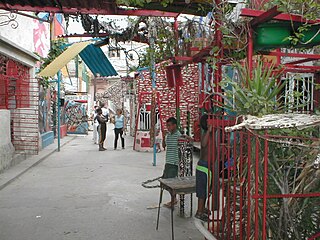
Amelia Peláez del Casal was an important Cuban painter of the Avant-garde generation.

Nancy Morejón is a Cuban poet, critic, and essayist. She was a recipient of the Struga Poetry Evenings Golden Wreath Award.

The Gran Teatro de La Habana is the former Centro Gallego. Designed by the Belgian architect Paul Belau and the U.S. firm of Purdy and Henderson, Engineers, was paid for by the Galician immigrants of Havana to serve as a their community- social center. Located in the Paseo del Prado, the theatre has been home to the Cuban National Ballet and to the International Ballet Festival of Havana. Its facilities include theatres, a concert hall, conference rooms, a video screening room, as well as an art gallery, a choral center, with several rehearsal halls for dance companies.
Humberto Castro is an important Cuban painter.
Pablo Amancio Borges Delgado is a Cuban artist.

José Braulio Bedia Valdés is a Cuban painter.
Adriano Buergo, is a Cuban artist specializing in painting, drawing and installations.
Juan Pablo Villar Alemán is a Cuban artist specializing in drawing, painting, engraving and graphic design. Since 1989, he resides in Mexico City, Mexico.

José Rodríguez Fuster is a Cuban naïve artist specializing in ceramics, painting, drawing, engraving, and graphic design.
Samuel Feijóo was a Cuban writer and artist specializing in painting and illustration.
Rodrigo Prats was a Cuban composer, arranger, violinist, pianist and orchestral director.
Punto guajiro or punto cubano – or simply punto – is a sung genre of Cuban music, a poetic art with music. It became popular in the western and central regions of Cuba in the 17th century, and consolidated as a genre in the 18th century. It has Andalusian and Canary Islands origins, and it integrated African elements in Cuba.
Guillermo de Cun was an actor, writer, director, and producer for radio and television.

José Manuel Fors is a contemporary Cuban artist born in Havana in 1956. His work is principally supported by the installation and the handling of photography as a support for his instalative practice. His first artistic forays, during the early eighties, were part of what has been considered as "The Renaissance of Cuban Art". His artworks have been shown in renowned museums and galleries in the United States, Europe and Cuba.
Carlos Enrique Prado is a contemporary Cuban artist. He has work in different such as sculpture, ceramics, drawing, digital art, performance, installations and interventions. Between 2002 until 2012, he was professor at ISA University of Arts of Cuba, where he was also the head of the sculpture program. He currently lives and works in Miami, Florida. He teaches ceramics and sculpture at University of Miami, Coral Gables, Florida. He recently completed the Ronald Reagan Equestrian Monument, located at Tropical Park, Miami. This public sculpture was commissioned by Miami-Dade County, Art in Public Places Office.

José Ignacio Sánchez Rius, better known as Josignacio, is a contemporary Cuban artist who is associated with neo-figurative and abstract painting.
The following is a timeline of the history of Havana, Cuba.
Felicia Chateloin Santiesteban is a Cuban architect specialized in conservation and rehabilitation of built patrimony and in urban historic preservation.

The Sociedad Económica de los Amigos del País de la Habana or Real Sociedad Patriótica de la Habana is a learned society in Havana, Cuba. It was initially organized to promote agriculture, commerce, education, and industry, modelled on the Sociedad Económica de los Amigos del País in Spain. Founding members included Diego de la Barrera, Francisco Joseph Basabe, José Agustín Caballero, Luis de Las Casas, Juan Manuel O'Farrill, Tomás Romay y Luis Peñalver, and Antonio Robledo. In its early decades the group produced publications, maintained a library in the Convento de Santo Domingo (1800-1844), and arranged educational programs. Around the 1790s the group built the Hospicio o Casa de Beneficencia in Havana.
Veerle Poupeye. Caribbean Art. London; Thames and Hudson; 1998.














